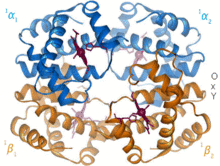Bohr effect
The Bohr effect describes the decrease in the affinity of hemoglobin (Hb) for oxygen when the pH value decreases or the CO 2 concentration increases. Together with the cooperative binding of oxygen and the allosteric effector 2,3-bisphosphoglycerate formed in the Rapoport-Luebering cycle by the enzyme bisphosphoglycerate mutase , this property ensures the optimal function of hemoglobin as an oxygen transporter.
The effect is named after its discoverer, the Danish physiologist Christian Bohr (1855–1911), father of the physicist Niels Bohr .
Basics
The hemoglobin mediates the task of the blood to transport oxygen from the lungs to the consuming organs. For this purpose, the hemoglobin must be able to bind the oxygen that is abundant in the breathing air in the lungs capillaries and to release it again in the target organs, where it is needed for energy metabolism .
Hemoglobin comes in two conformations: the tense form (T), which binds oxygen poorly, and the relaxed form (R), which binds oxygen well. Both forms are in equilibrium with each other, which is shifted to one side or the other depending on the environment.
Several properties of hemoglobin are responsible for controlling the binding and release of oxygen. The Bohr effect ensures a preferential release of oxygen in metabolically active tissues. Essentially, two factors play an important role: Metabolically active tissues, such as muscles during sporting activity, have an increased CO 2 content and a lower pH value . Both can be explained by the accumulation of metabolic products: carbon dioxide is created during cell respiration and reacts, catalyzed by the enzyme carbonic anhydrase , with water to form hydrogen carbonate and protons - the pH value drops:
The lowering of the pH value is intensified when there is not enough oxygen available for cellular respiration. Then the pyruvate obtained in glycolysis cannot be broken down via the citrate cycle . When the citrate cycle comes to a standstill, a kind of “backwater” occurs. So that the backwater does not also impair glycolysis and completely paralyze energy production, the pyruvate is reduced to lactate with the release of protons , which leads to further acidification of the blood. This process can be observed in muscles that work anaerobically , for example .
Effect of pH
The histidine residues 122 of the α-subunits and 146 of the β-subunits of hemoglobin and the α-amino groups of the N- terminal amino acids of the α-subunits are involved in the pH-dependent effect .
The pK s values of these groups are close to 7. The pK s values are in the T-shape than in the R form. A higher pK s value means that the proton uptake is thermodynamically favorable; The background here is that the positive charge of the protons in the T conformation can stabilize salt bridges that do not exist in the R conformation.
The normal blood pH is 7.4. When the pH value is lowered as much locally, that it is the pK s approximate value of these groups, this leads to a rapidly increasing protonation. Because the pK s values in the T-shape is higher than in the R-form, the low pH shifts the equilibrium between the T-form and R-form to the side of the T-shape, which with a lower average affinity for oxygen and is therefore associated with the release of oxygen. Lowering the pH value by 0.2 already results in a decrease in oxygen affinity by around 20%.
Effect of the CO 2 partial pressure
In addition to the pH-lowering effect of carbon dioxide described above, a second mechanism also plays a role. The hydrogen carbonate reacts reversibly with terminal amino groups of the hemoglobin to form carbamate groups .
This also leads to a shift in the equilibrium between T-shape and R-shape to the side of the T-shape and thus to a reduction in the average oxygen affinity. The formation of carbamate groups is also involved to a small extent (approx. 5–7%) in the transport of CO 2 back to the lungs.
Repentance
In the lungs the situation is reversed. Since the carbon dioxide partial pressure in the blood is higher than in the air, CO 2 passes from the blood into the air. Because CO 2 is removed from the chemical equilibrium, hydrogen carbonate reacts with protons to form CO 2 and water. The lost protons increase the pH value.
Also due to the chemical equilibrium , the carbamate groups hydrolyze again to amino groups and CO 2 . All of this promotes the transition of hemoglobin from the T-shape to the R-shape, which binds oxygen with a high affinity.
Therapeutic meaning
A targeted application of the Bohr effect is attempted in the Buteiko method .
Analytics
The local concentration of hemoglobin without oxygen (deoxyhemoglobin) can be detected in vivo by functional magnetic resonance imaging . When the blood flow increases, the local concentration of deoxyhemoglobin decreases. This method is known as the Blood Oxygen Level-Dependent Contract (BOLD effect).
See also
literature
- Berg, Stryer, Tymoczko: Biochemistry . Spectrum Academic Publishing House, 2007, ISBN 978-3-8274-1800-5
Individual evidence
- ↑ a b c Jan Mayer: Mental Training. Springer-Verlag, 2011, ISBN 978-3-642-13762-4 , p. 211.
- ^ Robert C. Eklund: Encyclopedia of Sport and Exercise Psychology. SAGE Publications, 2013, ISBN 978-1-483-36870-2 , p. 130.




